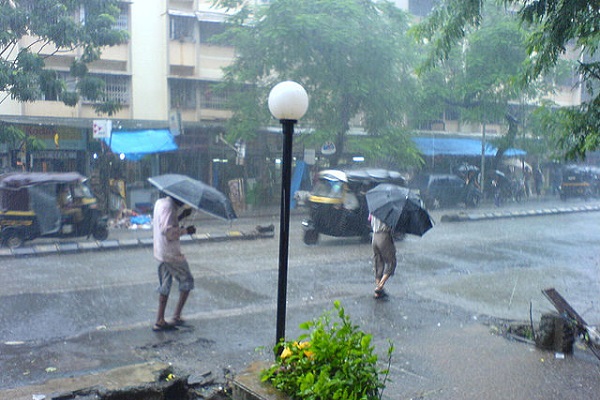Monsoons are not just rain and dance, or change of seasons. They are a time to seek one’s higher self, through moments of solitude. More so, when the pouring rain and dark, sombre clouds grant us a sense of seclusion, a welcome, ‘impromptu’ retreat at home — with a steaming cup of coffee.
Monsoon connects us to the earth and nature — the amplified, fresh ‘tang,’ or petrichor, of earth, grass, trees, leaves and the air. In a figurative sense, rain connects us to a different plane. Of feeling focused, with the ability to be comfortable with oneself and the environment. Notwithstanding all the inconvenience, monsoon ‘supplements’ a new melody too, a rain song that connotes inner peace. Ask someone around what it means to be ‘stuck in the rain.’ They will categorically tell you that it is a wonderful thing — something that gives them a little ‘me-time’ to unwind and think of themselves.
Monsoon restricts one’s movement, all right, so much so that reaching your workplace and returning home becomes a nightmare. Forget the creepy allegory, and you will only be cheerful for it, because tomorrow’s rain ‘waltz’ may be different with no flooding, or traffic jams.
Monsoon also provides us with the high ground to meditate with those lilting rain drops ‘caressing’ our mind — to gather fresh insights. For one who embraces the sonorous rhythms of the rains, one can hear and resonate with the voice of god. This isn’t just a simile, but a sign, or vision, a simple and refreshing epitome too that reconnects us with the divine essence. It provides us with a sense of serenity and solidity, especially in our turbulent times. The best part — there is no need for us to scan the horizons, because our introspectively retrospective view provides us with valuable insights, juxtaposed by a certain valour to tide over the inclement weather and its gusty winds of change.
Monsoon is a juncture to seeking answers to life’s numerous questions and puzzles. It is a phase to sow new ideas and reap their fruits with intuitive leaps. Because, when the mind is ‘animated,’ the more intense the learning is. There is yet another visage to the whole idea — when knowledge is sublime, wisdom lingers. Because, the mind is more than a tad clear of mental clutter, pride and arrogance? Yes. What’s more, when elevated wisdom resides in the conscious and the unconscious mind, the better the wholesome, uplifting experience of pure delight.
Monsoon exemplifies a time of pledge and fulfilment too with regard to reconnecting with long-lost friends, or values, and embarking upon a new rainy voyage that augments a new purpose in life. It is also a mind-body ‘detox’ process, followed by the planting of a new seed of good thought and harvesting a nice, mindful, rich crop. Once this happens, one is assured of a new-fangled, fresh space that promises something of equal, or greater, measure. The reason being — what is famously called divine insight is nothing but creating stillness in our mind, cultivating, or refining, our thoughts, perceptions and attitudes. Add to this discipline, patience and receptivity, and you have a colourful mosaic that provides a new spiritual connect to the humdrum of modern life and existence.
The dance of the raindrops has been encapsulated by great minds for ages. Ancient Eastern literature and mythology celebrated the monsoon — right from Rig Veda to Ramayana there’s a wide-ranging prominence bestowed to the occurrence. There are hymns in the Rig Veda devoted to Prajanya, a cloud, what with a heavenly eminence fixed to it. Just think of a sense of carnival and rapture allied with the rains in other cultures — be it Europe, the Americas, or elsewhere. Yet, there would be no comparison to the incomparable Kalidasa in his Meghadūta, the most celebrated, classic poem vis-à-vis the rain. It exquisitely showcases the voyage of a cloud, dexterously and allegorically, like no other, as the emissary for Yaksha’s wife.
When you think of the spell of a downpour, the pleasure of being drenched in the rain, you may be hypnotically drawn to Gurudev Rabindranath Tagore, “Rain streams softly on me, like dewdrops falling, they cool my brow.” Or, as the legendary American writer William Faulkner expressed in purple prose, “It begins to rain. The first harsh, sparse, swift drops rush through the leaves and across the ground in a long sigh, as though of relief from intolerable suspense. They are as big as buckshot, warm as though fired from a gun; they sweep across the lantern in a vicious hissing.”
Or, as the great English novelist and poet Thomas Hardy eulogised, “The air changed its temperature and stirred itself more vigorously. Cool breezes coursed in transparent eddies round Oak’s face. The wind shifted yet a point, or two, and blew stronger. In ten minutes every wind of heaven seemed to be roaming at large. Some of the thatching on the wheat-stacks was now whirled fantastically aloft, and had to be replaced and weighted with some rails that lay near at hand. This done, Oak slaved away again at the barley. A huge drop of rain smote his face, the wind snarled round every corner, the trees rocked to the bases of their trunks, and the twigs clashed in strife.”
You’d describe the rain symphony as collective intuitive wisdom — the quintessence of synchronistic events and recurring motifs in one’s tête-à-tête with one’s own inner self, or psyche. To use a metaphor, being in sync with the monsoon sonata is akin to being conceptualised in the composer’s mind. It bids fair to a receptive mind, because what is made possible from just an abstract thought provides sublime insight to one’s spiritual roadmap, provided you have an open heart and an equally open mind to orchestrate a rain-centric ‘equal music’ with your inner voice, or soul.
— First published in The Himalayan Times, Nepal
[Subject Photo: Courtesy, Rakesh Krishna Kumar]
